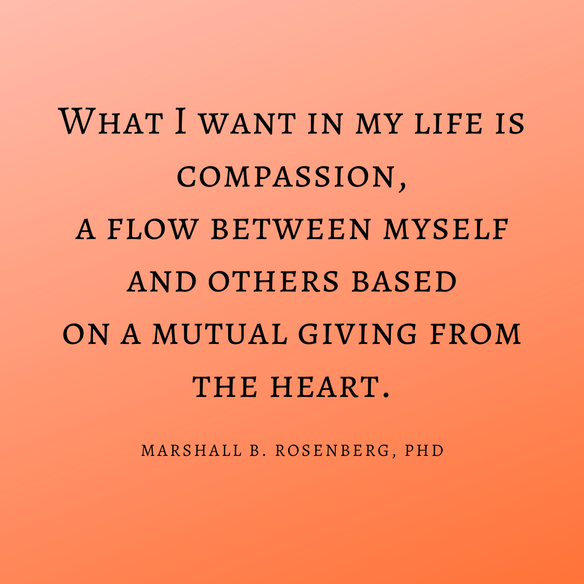Utilizing Compassion to Communicate Effectively With Nonviolent Communication

 An integral part of building healthy relationships is not only learning to communicate but learning to communicate effectively and efficiently. Although there are many different communication styles, we’re going to focus on one in particular – nonviolent communication.
An integral part of building healthy relationships is not only learning to communicate but learning to communicate effectively and efficiently. Although there are many different communication styles, we’re going to focus on one in particular – nonviolent communication.
With it’s emphasis on listening to ourselves and others, nonviolent communication helps us learn to really understand the deeper needs of ourselves and our loved ones. Nonviolent communication is “founded on language and communication skills that strengthen our ability to remain human, even under trying conditions” (The Center for Nonviolent Communication, 2019). Nonviolent communication teaches us that instead of listening simply to respond, we should be listening to understand and empathize with those we are communicating with. This can lead to more honest and open communication.To utilize Nonviolent communication, there are four various components to be aware of.
1. Observation: This refers to what we see or hear, things that we observe are stimulus for our reactions. Expressing our observations can help create a shared reality with the person you’re trying to communicate with. The “observation gives the context for our expression of feelings and needs” (I. Kashtan, M. Kashtan, 2020). The most important part to making an observation is to separate our own judgements, and simply speak on what we see or hear. For example, if we say “you’re rude” the person we’re trying to communicate with might disagree or become defensive. If we speak solely off our observation by saying “when you walked in, you didn’t say hello to me” the other person can now recognize the moment the way you observed it. Utilizing observational speaking will bring us away from right or wrong thinking, which can allow us or the person we’re communicating with to take responsibility for their actions instead of deflecting or arguing.2. Feeling: Feelings are emotional experiences or physical sensations that are associated with our needs that have either been met or remain unmet. When identifying feelings, try to identify and describe the inner experience rather than words that describe interpretations of people’s actions. For example: “I feel lonely” is describing your inner experience rather than “I feel like you don’t want to spend time with me” which describes an interpretation of how someone is acting or may be feeling. Identifying feelings in this way can help aid the process of taking responsibility for our experience rather than placing blame or criticism on others. Communicating in this way can increase the likelihood that the person will respond in a way that meets both of your needs.3. Needs: Every human experiences feeling specific needs that can sustain or enrich our lives. Understanding, naming and connecting with our needs can help us improve our relationship with ourselves and others. The “key to identifying, expressing, and connecting with needs is to focus on words that describe shared human experience rather than words that describe the particular strategies that meet those needs” (I. Kashtan, M. Kashtan, 2020).
4. Requests: Making requests refers to identifying and expressing specific actions someone can take to help meet our needs. There are different types of requests we can utilize to have our needs met. For example, requests made in the moment are usually ‘connection requests’ and are intended to foster a connection and understanding to determine if we can move forward to a ‘solution request.’ An example of a connection request might be “would you tell me how you feel about this?” Whereas an example of a solution request might be “would you be willing to take your shoes off when you come in the house? Learning to make requests, rather than demands are integral to effectively utilizing nonviolent communication.
Here is a cheat-sheet you can use when communicating with someone while using the four components of nonviolent communication. You can download it here.
Now that we’ve gone over the four components of nonviolent communication, we can move onto the two parts on nonviolent communication. The two parts should be practiced the entire time you’re communicating.
1. Empathy: This is the process of connecting with another person by guessing their feelings and needs. Practicing empathy allows us to put ourselves in another person’s shoes to see how situations might affect them from their perspective.
2. Honesty: Honesty begins “with truly understanding ourselves and our own needs, and being in tune with what is alive in us in the present moment” (The Center for Nonviolent Communication, 2019).
Utilizing the four components and two parts, we can begin to create a dialogue for communicating effectively. Here is a basic outline:
I feel ______________
because my need for ________________ is not met.
Would you be willing to __________________?Nonviolent communication does not come naturally to most of us, and is something that should be practiced either on your own, with someone else or with your therapist.You can learn more about Nonviolent communication here.
Rosenberg, M. B., & Rosenberg. (2019). NVC Instruction Self-Guide. Retrieved February 13, 2020, from https://www.cnvc.org/online-learning/nvc-instruction-guide/nvc-instruction-guideKashtan, I., & Kashtan, M. (n.d.). Basics of Nonviolent Communication. Retrieved February 13, 2020, from https://baynvc.org/basics-of-nonviolent-communication/
Rosenberg, M. B. (2009). The 4-Part Nonviolent Communication (NVC) Process. Retrieved February 13, 2020, from https://www.nonviolentcommunication.com/aboutnvc/4partprocess.htm
